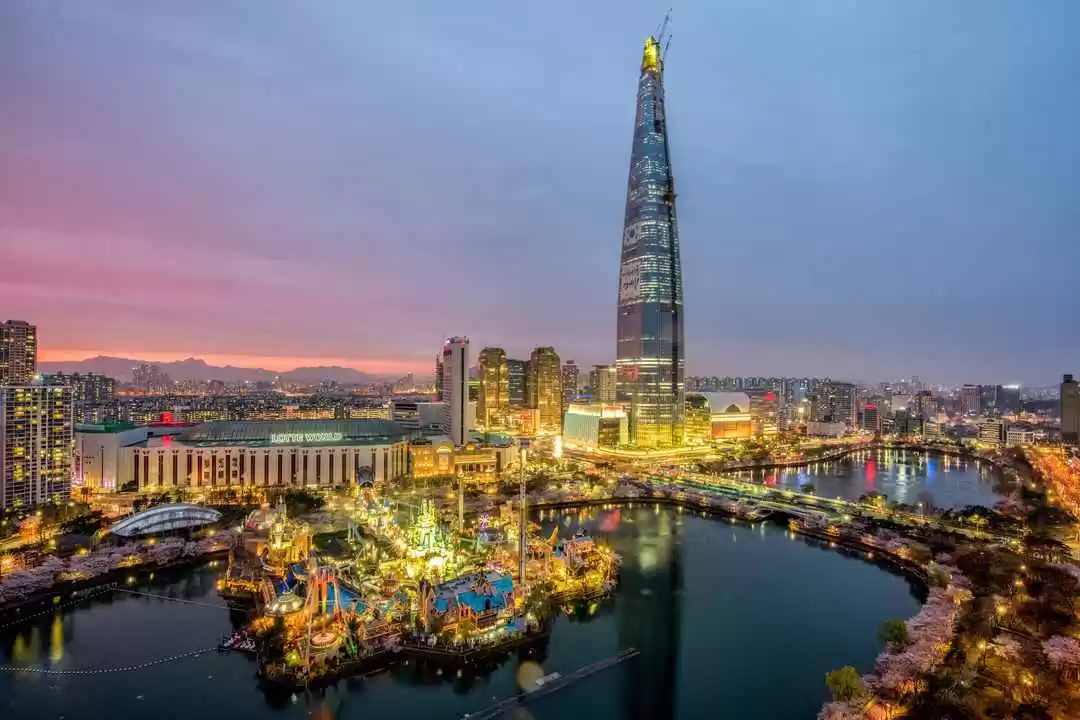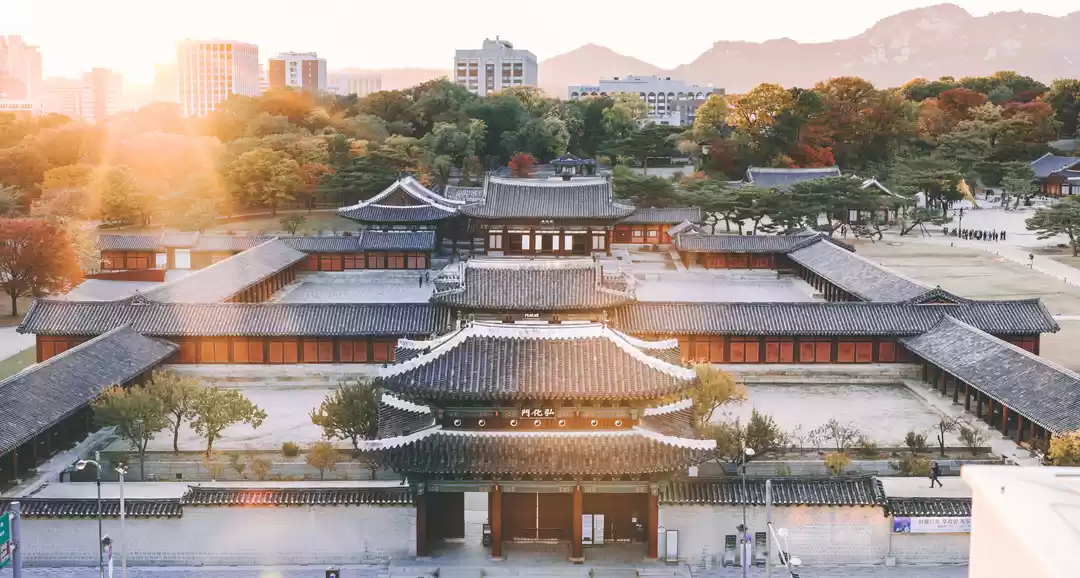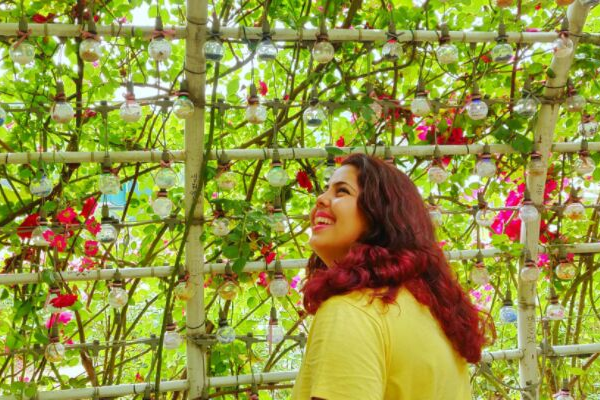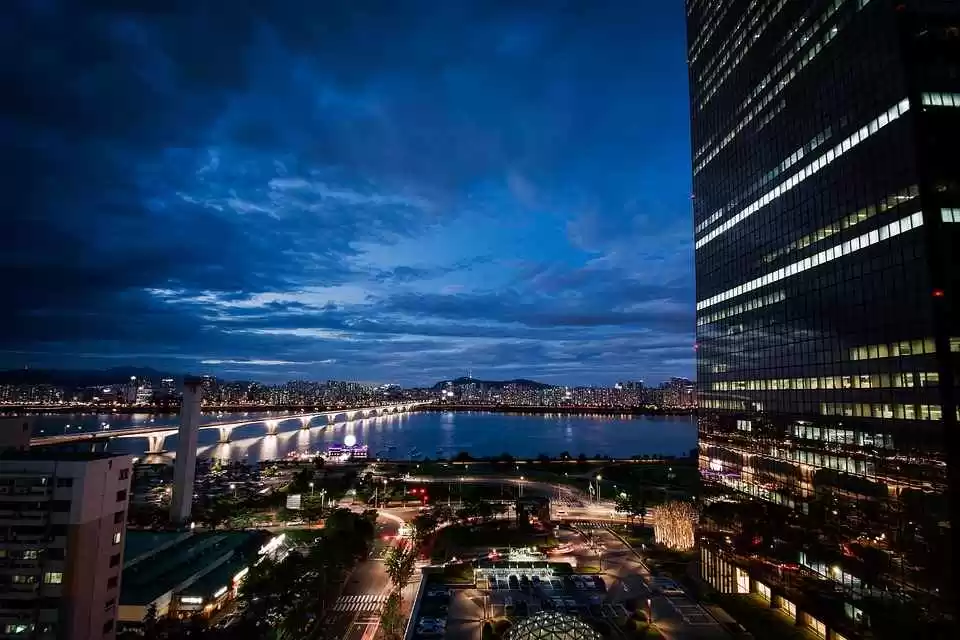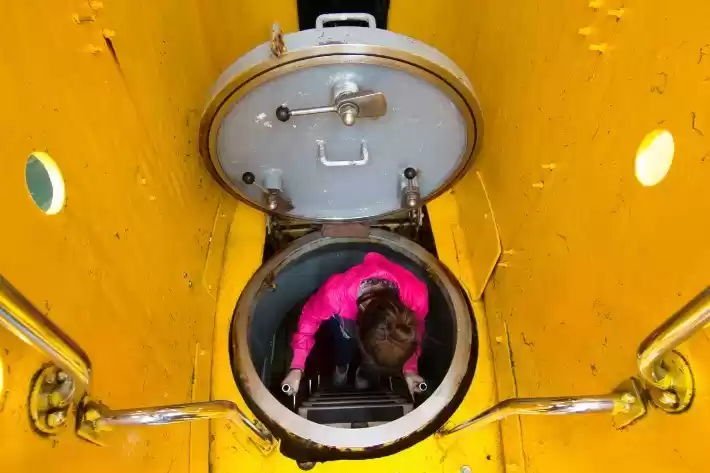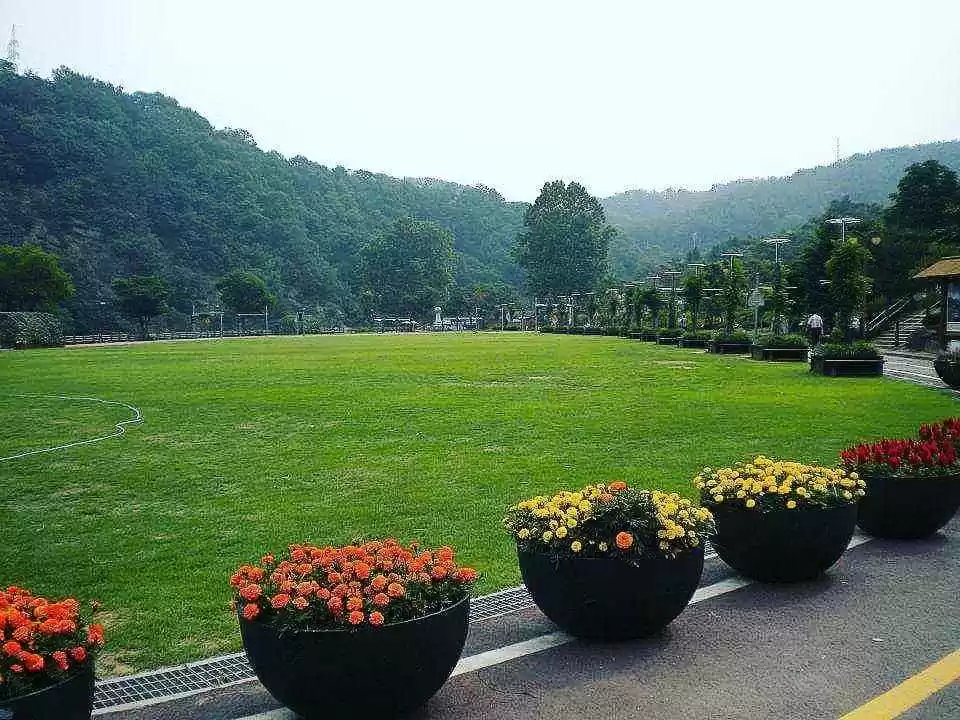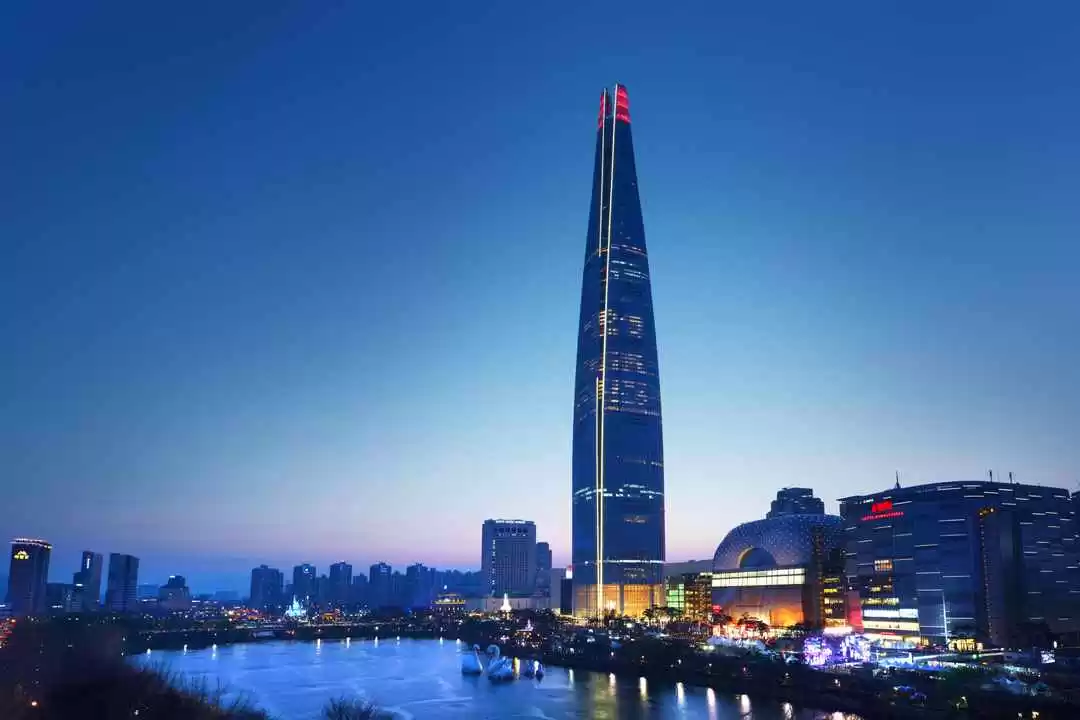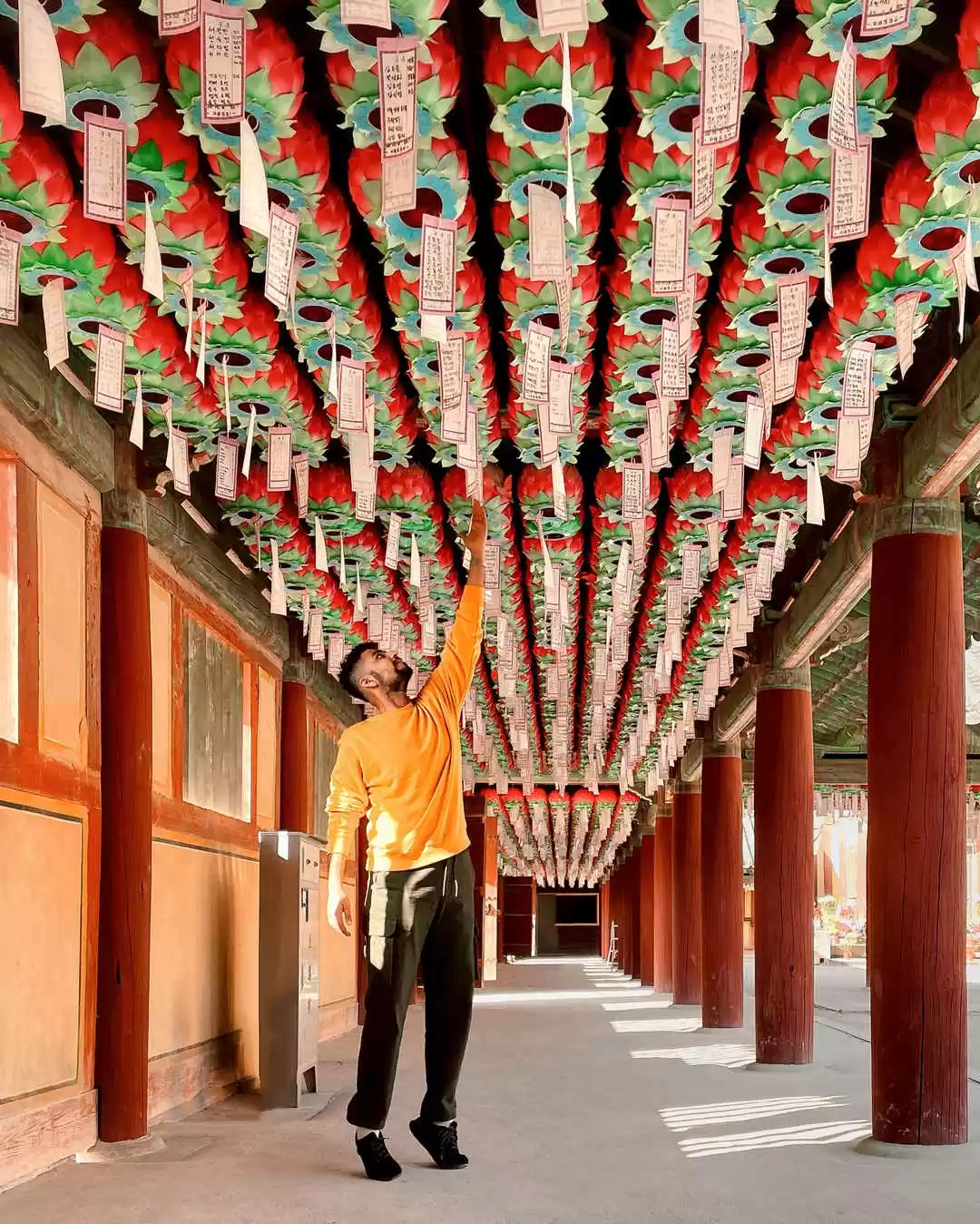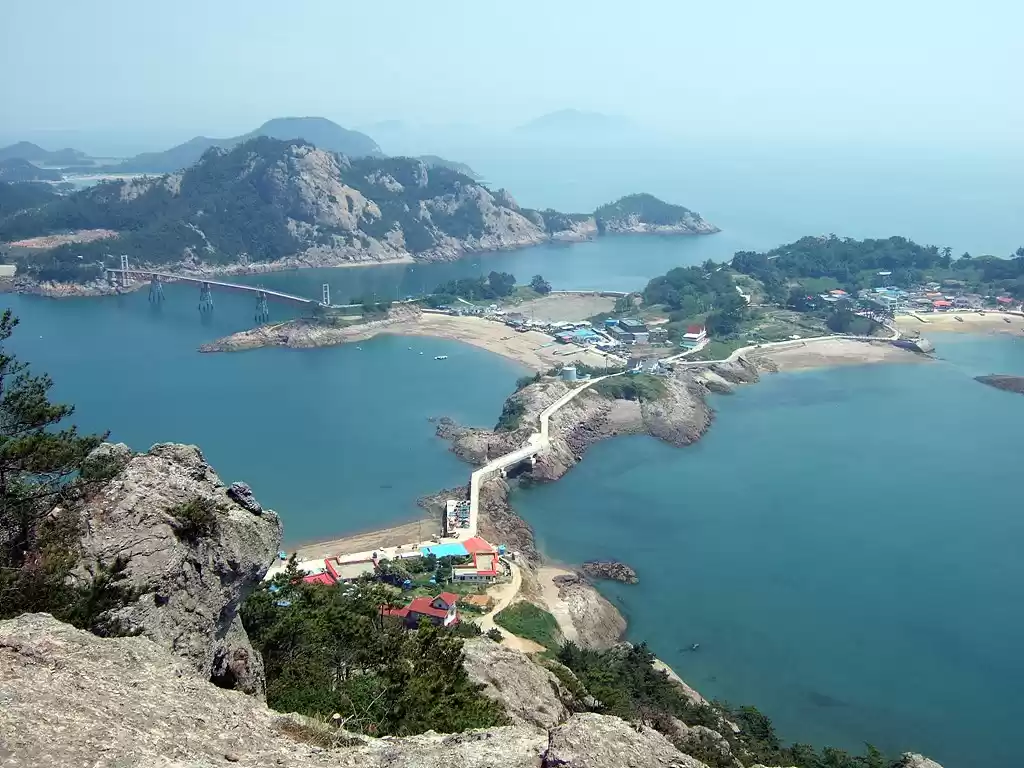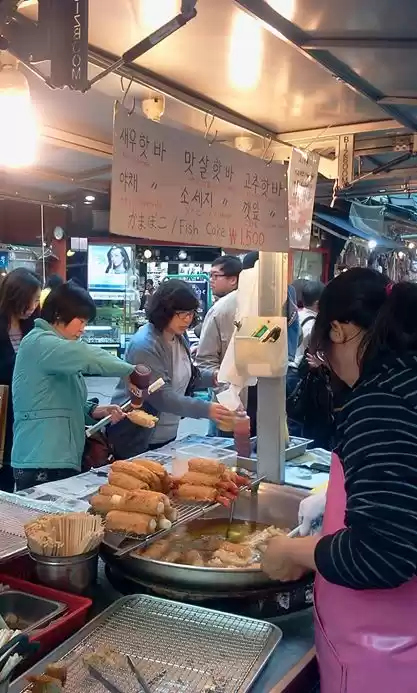South Korea Tourism and Travel Guide
All You Need To Know About South Korea: Itineraries, Guides, Best Things to Do & More
Take a Virtual South Korea Tour: The Country In Pictures & Videos
Post About Your South Korea Trip & Make it to Editor's Picks
Best Time To Visit South Korea
South Korea tourism sees the most traffic during the country’s pleasant spring months of April, May and June and autumn months of September, October and November. These months are optimum for visiting South Korea tourist spots as these days are sunny and dry with a comfortable temperature.
There are minor regional variations in temperature due to the high altitudes in some parts and windy and warm climes by the sea.
There are four distinct seasons experienced by the country that emphasize the attraction of certain places:
Spring (April to June):
This is the best time for South Korea tourism, with the temperature average a mellow 15-18 degrees and cherry blossom trees abound, especially in Gyeongju, where walks are full of blossoms softly falling around you. These sunny days witness a lot of festivals and are the perfect time to head to national parks such as Songnisan, Seoraksan and Jirisan. However, expect crowds at South Korea tourist spots as tourism in Korea is at its peak during spring.
Summer (July to August):
Summers here are brief and temperatures soar up to 30 degrees. South Korea tourism also sees spells of rain during this time so the weather gets humid. Seek shelter in Seoul’s air-conditioned malls or take yourself to sparkling beaches of Busan around this time.
Autumn (September to November):
South Korea tourism lures in crowds during this period as the country explodes into vivid shades of colour. The lush greenery in South Korea’s national parks turn into orange and red and shed leaves of gold. Sun yourself at the seaside resorts at Jeju or seek the solace of the hills but remember to pack a few extra layers. The weather is mellow with temperatures between 19 to 21 degrees with a few brief showers.
Winter (December to March):
Temperatures during this period change drastically and drop to a sharp -20 degrees in northern regions such as the Gangwon-do province. The coastal regions see relatively milder temperatures. However, South Korea tourism retains its charm during this period as well as soft snow carpets the slopes and valleys to create opportunities for skiing and snowboarding at Gyeonggi-do Province and Gangwon-do.
Visa Information for South Korea
Indians do need a visa to visit South Korea but fortunately, South Korea tourism has made it easy for tourists to get a visa. You can apply for a visa at the South Korean consulate in your city and get a 90-day visa. If you only want to visit Jeju island you do not require a visa.
Thanks to South Korean tourism’s efforts you can get a visa online as well. Simply submit the required documents, pay the visa fee online and receive your visa.
However, there’s a hidden hack that not many know about. Believe it or not, you can visit South Korea without a visa for 30 days. Most nationalities except Macedonia, Cuba, Syria, Sudan and Iran can take advantage of this special feature by South Korea tourism.
Here’s how it works. If you are visiting South Korea en route to Europe, USA, Canada, Australia, New Zealand, then you can stay for 30 days ‘in transit’ in South Korea without a visa. To make this work you must have confirmed tickets to your next destination. You need to leave and get to your destination within three days of leaving South Korea so India-South Korea-destination works.
You must have a visa for your final destination however and again, this must be a US, Canadian, Australian, Kiwi, or European visa in your passport. A resident permit is also allowed. This feature of South Korea tourism also works if you’re visiting South Korea on your way back from any of the mentioned countries, however, you must have a direct flight to South Korea from the mentioned territories. It is advisable to be prepared with documents in case you run into issues at the airport.
Top Attractions In South Korea
South Korea tourism offers ancient imperial palaces, green rolling countrysides, quaint old towns and villages with Korean heritage, lush national parks, urban South Korea tourist attractions and temples to marvel at. Here are a few South Korea tourist spots you can visit:
1. Gyeongbokgung Palace
Gyeongbokgung translates to ‘a place where the new king can enjoy the prosperity of great blessings’. The palace was built by the founder of Joseon dynasty, King Taejo and was the residence of the royal family until 1592 when the Japanese invasions led to the palace being burnt down. In ruins for over 300 years, the palace was rebuilt again at great cost.
The beauty of the palace adds greatly to South Korea tourism; visitors flock to get an eyeful of the beautiful property consisting of 330 buildings. It is said that there was a veritable army of staff, almost 3000, including eunuchs which were at the service of the royal family.
At the Gwanghwamun Gate, the popular Royal Guard Changing Ceremony takes place, a cultural performance which draws in crowds. You’ll get a glimpse of the ornate and regal architecture that South Korea tourism boasts of in the form of its palaces. The gate itself is guarded by two ferocious haetae, mythical lion-like creatures.
A courtyard stands in front of a double-storeyed Geunjeongjeon, the main palace building. The building with open-sided corridors was used for coronations, governance and important meetings.
Other features in buildings include a high pavilion supported by 48 stone pillars looking towards an artificial lake with two islands used for splendid banquets and boating by the royals.
South Korea tourism offers an audio commentary and free guided tours for anyone who wishes to learn more about the regal structure. There are also two-hour starlight tours in mid-March and mid-April where you can enjoy a 12-course meal based on Korean royal cuisine, a gander at the royal kitchens to envision how feasts were prepared and an evening tour of the palace which ends with a live performance of Korean music on the pavilion which overlooks a lake.
Guided tours happen at 11.00 am, 1.30 pm and 3.30 pm. The starlight tours occur at 6.30 pm and 7.40 pm from mid-March to mid-April.
Cost of starlight tours: Rs 3,118
Entry cost: Rs 180 per adult
2. Changdeokgung palace
Another gem in South Korea tourism’s crown, the Changdeokgung palace was built in 1405 when the Gyeongbokgung was burnt down during the Japanese invasion. The royal family stayed here until 1872.
In the Joseon style of architecture, the palace is set against a mountain with a stream gurgling past. The Donhwamun gate is impressive and large and is the largest among all gates in Seoul’s palaces. A stone bridge built as far back as 1414 still stands with guardian animals in stone standing guard.
The main palace building, Injeongjeon, has a courtyard facing it with open corridors and trees. Gawk at the rooms where the royal family resided with remnants of antique furniture. The grounds also have woodlands and a decorated garden, the 78-acre Huwon which is replete with pagodas, streams, lakes, pathways and lush greenery.
Marvel at the palace’s beauty under silvery moonlight as South Korea tourism offers Moonlight tours. These tours only allow up to 100 people and tickets can be bought online.
Cost of Moonlight tours: Rs 1,800
Cost of entry: Rs 500 including Huwon
Timings: 9.00 am - 6.00 pm
3. Jeonju Hanok Maeul
An attraction of South Korea tourism is its maeul ((village) such as the Jeonju Hanok Maeul which still has over 800 hanok (traditional wooden homes) which make one feel that they’ve gone back in time. The cobblestoned lanes and ancient temples add to the old world charm and make one feel like they’re back in old Korea. The air is peaceful and is tinged with the smell of local Korean cuisine in the many restaurants and cafes here. The place is popular with tourists owing to its well-preserved heritage and is home to many guesthouses.
Rent a hanbok (traditional clothing) to lull yourself into the times of the wistful Korean past. Sample some of the grilled food there or explore the area on foot. Jaman village has some great street art to see. There are also workshops held here on traditional paper and alcohol making. South Korea tourism has tourist information centres where you can sign up for such workshops.
4. Seongsan Ilchul-bong
A natural South Korea tourism attraction is the Seongsan Ilchul-bong, a 182 m-high extinct volcano. The place is shaped like a bowl and is so impressive it’s been named a UNESCO World Heritage Site. The crater is fringed by jagged rocks and houses dense forests. You can climb up to the crater rim within 20 minutes. Make sure you catch the beautiful sunrise or sunset here which is a treat for the eyes.
The sunrise expedition starts early so you might have to stay a night at Seongsan-ri, a small village with motels and restaurants. If you’re here during the New Year stay for the Seongsan Sunrise festival.
Cost for entry: Rs 124
5. Noryangjin Fish Market
The popular fish market is a culinary experience. If you’re expecting something swanky, then this place is not for you. South Korea tourism encompasses all kinds of attractions and this place is as unpretentious as it gets.
This place is South Korea’s largest fish market and has a wide variety of seafood. The place is full of almost 700 fish shops and many restaurants. Auctions occur around 1.00 am if you can stick around for that long. You can choose to eat a meal here when vendors hawking their wares offer to sell live crabs, prawns, meongge (Korean sea squirt) for the more adventurous kind and platters of hoe (raw fish slices). You can purchase the seafood and take it to the restaurants there who will serve you the food along with side dishes which will cost you about Rs 200 per person. You can also ask them to cook the seafood into dishes which will cost you an extra Rs 300 which is a pretty good deal.
6. Cheong-gye-Cheon
An urban hotspot, another attraction in South Korea tourism’s bank is this stream in the downtown area where people gather for a breather from the rushed pace of life in Seoul. With bridges, walkways, pretty waterfalls and public artwork, the South Korea tourist spot has become a hit with Seoulites. There’s a large pink and blue shell which is a piece of art, named Spring in the Cheong-gye Plaza. The stream is lit up with lights as evening gathers. You’ll spot lovers as well as families and friends, at their 22 bridges. Many come to beat the heat and dip their feet in the water.
South Korea tourism spent a whopping 384 million dollars on this project and tore down a highway to emphasise the stream. The water is pumped in from elsewhere to create this artificial highlight which flows for 5.8 km.
Activities And Things To Do In South Korea
South Korea has got a wide array of activities to indulge in, tailor-made for all kinds of travellers. The hedonists looking for a night to remember, the foodie on the prowl for new tastes, the nature lovers seeking solace in islands and forests and the traveller out to experience everything. With a range of offbeat and popular activities offered by South Korea tourism, there’s no time to get bored here.
1. Explore Seoul on foot
Seoul, the pulsating heart of South Korea has everything a die-hard urbanite could want. From historical museums, swanky malls, upscale restaurants, trendy pubs, hidden gems and K pop culture to Joseon dynasty palaces, traditional hanok villages and street markets — there’s plenty to distract yourself with.
Although South Korea tourism offers sightseeing tours where South Korea tourist places are bunched up for an overall view we recommend getting out on foot and exploring the place with its back alleys and culture.
Head to the Bukchon Hanok Village, which is perfect for a stroll. Historical and contemporary culture collide here with its charming alleyways studded with traditional Korean architecture.
2. Have a whale of a time at amusement parks
Let your hair down and have some fun at South Korea’s amusement parks designed by South Korea tourism for fun outings for families.
One such amusement park with a lot of fixtures is Lotte World. The park is located in the middle of downtown Seoul and has two parts, an indoor theme park and an outdoor theme park called Magic Island. Kids will love this facet of South Korea with its fun rides such as a carousel, Spanish pirate ship and flume ride and an outdoor section with rides that offer greater thrills such as the Gyro Drop and Spin. They also have artist workshops and folk performances that entertain.
If you’d like something bigger and better with more adrenaline-pumping activities, South Korea tourism has got that too. Korea’s version of Disneyland, Everland has an array of rides. The famous T-Express ride goes 100 miles per hour and is guaranteed to make you scream your lungs out. The park has five zones such as Global Fair, Zootopia, European Adventure, Magic Land and American Adventure. Each has its own unique attractions, for example, Zooptopia has pandas, giraffes and lions you can visit and also a famous speaking elephant!
Cost for one day pass for Lotte World: Rs 3,368
Cost for a day pass at Everland: Rs 2,124
3. Shop
Shopaholics rejoice! South Korea tourism has plenty of quirky spaces where you can shop to your heart’s content and pick up souvenirs galore for people back home.
Visit InsaDong Street in Seoul to witness South Korea tourism’s lively side. The street has street performers juggling and performing card tricks. If you’ve got a few tricks up your sleeve, then you can dazzle the crowds and even earn some extra bucks!
Browse through the shops lining the thoroughfare for traditional crafts and souvenirs and take a breather at the restaurants and cafes in hanok buildings serving food and tea in the side lanes.
You can also visit Ssamzigil which is shaped in a square and has four storeys full of art galleries, boutiques, shops selling handicrafts and furniture and more. The fourth floor also has a garden.
Another unique shopping spot in South Korea tourism is Meyongdong. Full of mid to high-end boutiques with the latest in fashion, the place is haunted by a hip young crowd for steal deals. You can get some cheap options at their duty-free shops or sample some of the sizzling street food there.
Hongdae is full of distractions in the form of live music bars, amazing art splashed across walls, cafes and clubs. South Korea tourism here offers an eclectic nightlife to let down your hair at the many clubs and live cafes that spill neon lights and music over their thresholds. There’s also the Trick Eye Museum here that has interesting visual illusions to get you sniggering and taking pictures.
By Gangnam we don’t mean the viral ‘Oppa Gangnam Style’ song; Gangnam is another region in South Korea tourism’s bank of places to visit where high-end restaurants, cafes and malls beckon you to come to spend a few hours’ worth of pleasant time.
4. Ski down Winter Olympics slopes
Turn into a ski pro at Winter Olympics slopes of South Korea tourism. That’s right! The Winter Olympics and Winter Paralympics in Pyeongchang was hosted by South Korea in 2018 and the Korean Alps, the Taebaek Mountains that stretches along the eastern side of the country was the site for the prestigious event. The highest point here in Gangwon-do at a dizzying 1,708 m. Visit Pyeonchang during winter to experience pristine white slopes full of soft snow.
It’s easy to get here due to South Korea tourism’s high-speed rail line that takes you to the Taebak Mountains’ ski sites.
If you’d rather stick closer to Seoul than there a few ski resorts nearby as well, such as the Konjiam Ski Resort and the Elysian Gangchon Ski Resort that are only about an hour away. South Korea tourism has made travel easier by introducing shuttle buses that take a day to ferry you to these ski sites.
Where To Stay In South Korea
While where you stay will depend on where you’re visiting, most opt to stay in Seoul for its lively cosmopolitan vibe. For tourists who’d love to do a bit of sightseeing as part of their itinerary, South Korea tourism has a range of options depending on how much you’d like to spend. The best place to stay for tourists would be Myeongdong or Dongdaemun while Itaewon is for those who love to shop owing to its proximity to Seoul’s shopping scene. There are plenty of luxury hotels for those looking for the finer things in life, mid-range hotels and boutique hotels who want to spend moderately and still have a great experience and budget stays for those who’d like to save some big bucks.
Luxury Hotels
There is a slew of luxury hotels offered by South Korea tourism to experience the best of hospitality. Enjoy rooms with stunning views of the city, unwind in marble bathtubs, relax at beautiful spas or tuck into gourmet delicacies. A stay at these hotels could cost anything between Rs 11,000 to Rs 24,000 per night.
Four Seasons Hotel Seoul
InterContinental Seoul COEX
Grand InterContinental Seoul Parnas
Park Hyatt Seoul
Banyan Tree Club and Spa Seoul
Conrad Seoul
Boutique hotels
South Korea tourism has quirky and eclectic boutique hotels that cater both to your tastes and budget. These hotels have tons of spunk and pizzaz and make your stay brighter by their signature styles. A stay at these hotels could cost you anything between Rs 2,500 to Rs 10,000 per night.
Hanok Guesthouse 201
Makers Hotel
Amanti Hotel Seoul
Aloft Seoul Gangnam
RYSE, Autograph Collection
Budget stays
Budget travellers who focus on the economy have plenty of options to choose from among South Korea tourism’s guesthouses and hostels. You can easily get a room for yourself in a guesthouse for around Rs 1,500 or a bed at a dorm for around Rs 600 per night.
Myeongdong Good Stay Guesthouse
Feliz Casa
Blue boat Hostel Myeongdong
Insadong Hostel
Cuisine And Best Places To Eat
One of the best ways to experience South Korea tourism’s culture is through trying the prevalent cuisine found in restaurants, street stalls and cafes. Koreans love a good barbeque or a plate of kimchi (fermented cabbage) which has been awarded the Intangible Cultural Heritage of Humanity title by UNESCO, so you know what to try when you get there. Apart from a good plate of kimchi, South Korea tourism offers other traditional culinary delights.
One of the best ways to get a taste of South Korea tourism’s cuisine is by taking to the streets. Street food sizzling in outdoor stalls are full of flavour and at economical rates. Let the aroma pull you towards market areas brimming with food stalls or pojangmachas as they are called, for a taste of authentic South Korean cuisine.
We will list out some must-try food items along with the restaurants and eateries you must visit to gorge at!
Gogigui
This is what South Korea tourism’s wildly popular Korean BBQ is known as. Restaurants and eateries have a grill in the middle of the table where uncooked or semi-cooked pieces of meat are given out to customers who proceed to cook them on the grill and proceed to devour them. Best had in groups you can put on some pork or samgyupsal or beef or sogogi on the fiery grill to get it crackling. Call for some soju to wash it down with.
A Korean BBQ is South Korea tourism translates to a community activity where eating amidst friends and family is a lot of fun. The meat is typically wrapped in lettuce or perilla leaves and eaten with sides like ssamjan paste (fermented bean paste mixed with chilli pepper paste), raw garlic, onions or marinated beansprouts.
Where to eat:
Most of the restaurants in the Mapo neighbourhood near Gongdeok station are pretty great. Anthony Bourdain had visited this area to dig into some Korean BBQ in Seoul which speaks volumes about the food here. A good place to gorge at would be Jeong Daepo.
Location: 7, Donhwamun-ro11ga-Gil, Seoul, South Korea
Chicken and beer
Ask for a plate of Chimaek and Maekju and this is what you’ll get. Another hot favourite culinary delight of South Korea tourism, chicken and beer started gaining popularity in the early 1970s. Fried chicken is served with watered-down Korean beer which makes for a yummy combination.
Though the traditional way of cooking fried chicken is by covering the chicken in a thin starch-based coating mixed with aromatic spices, some places have taken to selling fried chicken with a thick flour-based coating. You’ll know which one to pick.
Where to eat:
There are plenty of chicken and beer shops but for an authentic taste avoid the more commercial, mainstream spots. The good places will have plenty of middle-aged people digging into greasy chicken such as Two-Two Chicken, a franchise run by a warm and welcoming couple.
Location: Outside Gongdeok station, Seoul
Kimchi Jjigae
This is generally considered as South Korea tourism’s comfort food and goes great with chilly nights in South Korea. The dish is a stew full of flavours of kimchi, scallions, pork, tofu, tuna or other forms of seafood.
Where to eat:
You can try it at simple diners like Kimbap Cheonguk or head to Omori Jigae for their smooth flavours of Kimchi Jjigae.
Ddeokbokki
If you want to experience true South Korea tourism, then you have to taste the Ddeokbokki, a popular Korean street snack. Made from rice cake, fish cake and sweet and spicy red sauce, the item is found in street stalls, eateries as well as restaurants.
Where to eat:
Try this item at this stall called Cheong-Nyun Tteokbokki near Express Bus Terminal station which serves it with a soupy and spicy broth.
Location: Express Bus Terminal (Goto Mall), 1-9 Banpo 2(i)-dong, Seocho-gu, Seoul
Try pork bellies or samgyetang at Tosokchon Samgyetang near Gyeongbokgung Palace.
How To Travel In South Korea
South Korea tourism has led to a stellar transport system ensuring that transportation throughout the many regions here is inexpensive and hassle-free.
You can get a T-money card when you arrive at Incheon airport. This is a transport card which can be used for both bus or train journeys. This card can be used for subway rides as well. Skip long queues for a ticket each time you travel with this card which simply lets you tap in-tap out. One ride would cost you about Rs 170.
Train: An efficient South Korea tourism administration has ensured that the transport in its capital, Seoul is good. Trains run on time and you only have to wait for about five minutes. You can take the Airport Express train from Incheon airport. You can get an AREX coupon on your train card for around Rs 550 or take the normal train which is a little slower for Rs 250.
Buses: There are shuttle buses that run to places on the outskirts of Seoul courtesy South Korea tourism as well as inter-city buses. You’ll only have to wait about ten minutes for a bus.
Taxis: If you’d rather travel in taxis then there are plenty of them to hail here right on the street and are pretty safe. There are no car-sharing apps here.
You can use Google Maps but the efficacy here is limited. Instead, South Korea tourism’s Kakao Maps app is pretty good.
Typical Costs In South Korea
South Korea tourism welcomes all kinds of travellers to the country. Hedonists looking for a taste of luxury, mid-range travellers who’d like comfort under a budget and budget travellers who’d like to focus on economical spending.
The major cost that makes up a trip to South Korea tourism is about Rs 28,000-35,000 for a round trip journey by flight. You should ideally book a ticket about seven to eight weeks in advance.
Luxury travel: Combining hotel costs, taxi costs and food costs, luxury travellers can expect to spend anything between Rs 1,50,000 to Rs 2,70,000.
Mid-range travel: South Korea tourism is pretty reasonable so you won’t have to blow big bucks for comfort. A mid-range budget traveller can spend Rs 10,000 per day and stay here in comfort. Food normally costs around Rs 2000 per day with meals at restaurants costing about Rs 730. Expect to spend around Rs 900 per person on transport.
Budget travellers: South Korea tourism has ensured that budget travellers can also have a good time here. There is an Indian community here and you might be able to arrange a homestay at someone’s place. Alternatively, there are many hostels and guesthouses where accommodation is cheap. Try Korean street food instead of food at restaurants and traditional alcohol like Korean beer or soju. Use public transport to minimise costs and you’ll only have to spend about Rs 2,300 per day including everything.
FAQs
1. How many days do I need to explore South Korea tourism?
Travellers generally spend four to five days here as South Korea is a small country. Every place is well-connected by trains except the islands.
2. What are the things I should pack for a trip to South Korea?
You should pack a power strip so that your phone doesn’t run out of juice while travelling. Pack clothes according to the season you’re travelling in. Winters, especially in the higher regions, are harshly cold so pack several layers of warm clothing while summers should have you packing lighter clothes. Carry an umbrella for those sudden spells of rain.
3. Suggest three tips for planning a trip to South Korea
You can get a T-money card when you arrive at Incheon airport. South Korea tourism has ensured that this transport card can be used for both bus or train journeys. This card can be used for subway rides as well. Skip long queues for a ticket each time you travel with this card which simply lets you tap in-tap out. One ride would cost you about Rs 170.
It is recommended that you get a prepaid local SIM card here. It is useful for all travellers to have an internet connection while travelling. You can get on at convenience stores in Seoul or at the airport.
Download Google translate or a translation app if you don’t know Korean. Locals mostly do not speak English.
4. Which are the lesser-known places to visit South Korea?
Do visit the Jeju Si island which has a Geopak, a biosphere reserve and cultural sites that have won many UNESCO awards. The island is replete in beauty and is a dormant volcanic island. Make sure you visit the islands, each more beautiful than the last.
5. How do I reach South Korea from India?
You’ll have to take a flight from a major airport from India to land at Incheon airport. You’ll need a visa for South Korea for all places except Jeju Si island.


